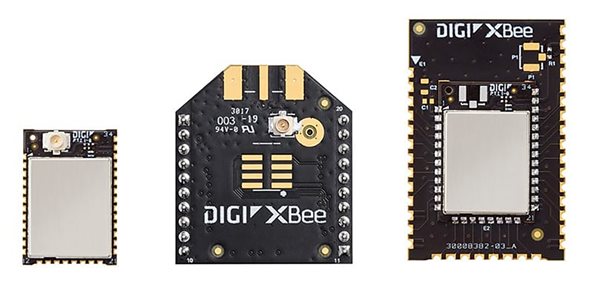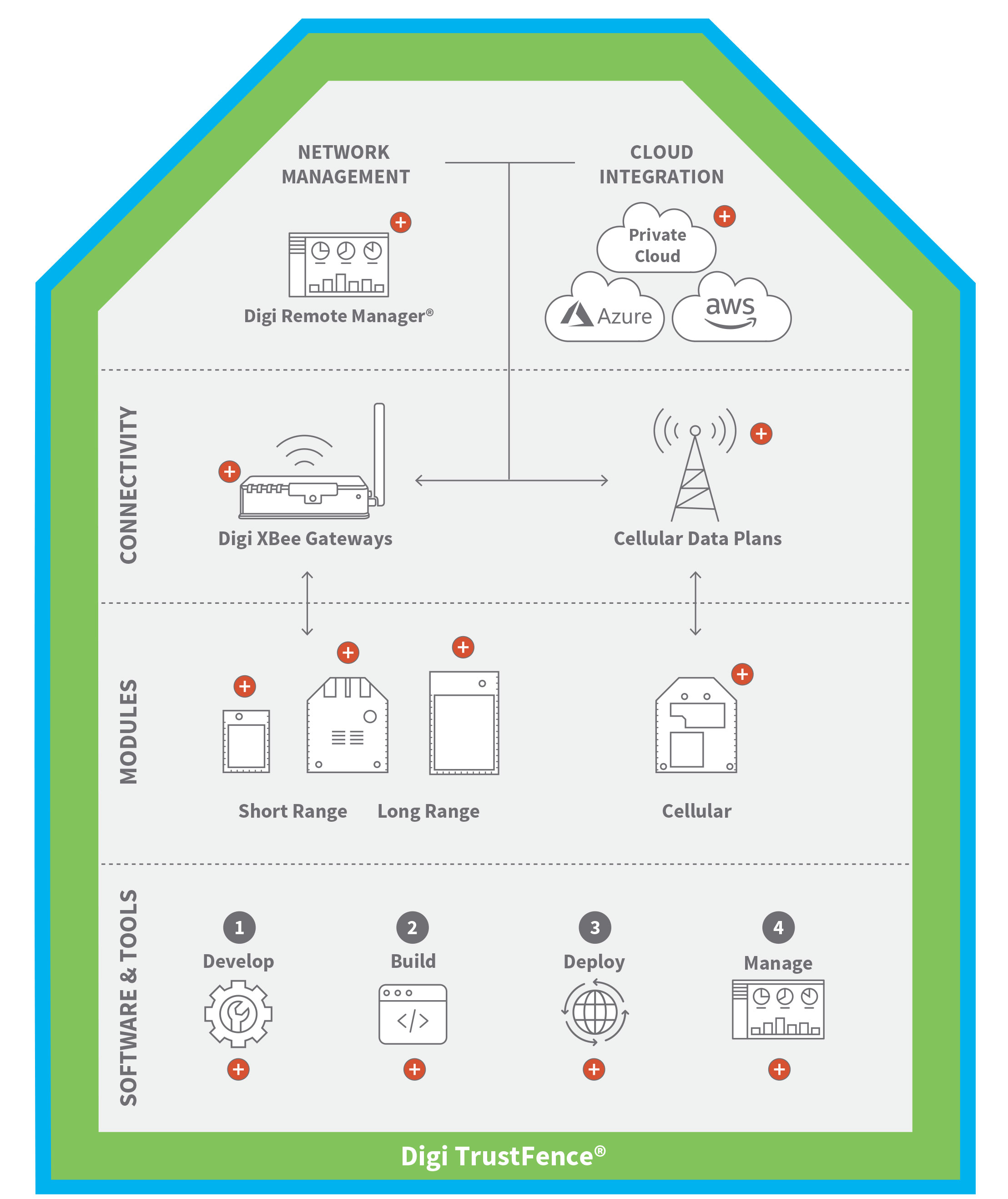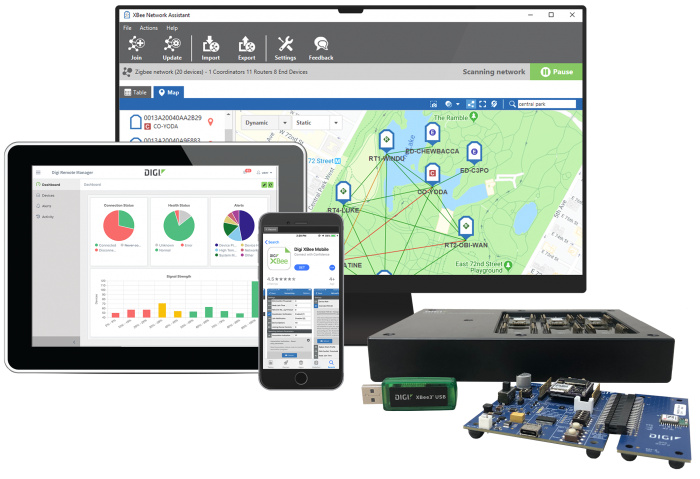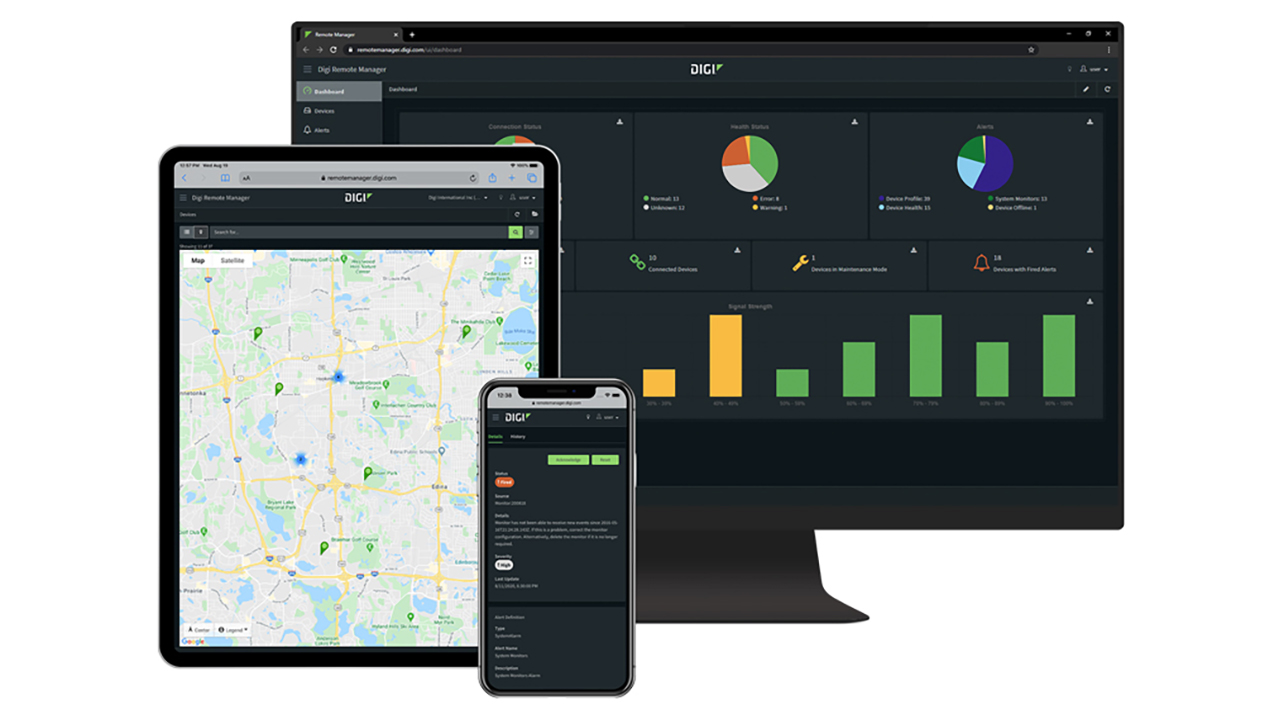XBee® and Zigbee® have some commonalities and share a relationship. XBee is a family of radio modules and is a registered trademark of Digi International. Zigbee is a wireless communications protocol and a registered trademark of the Zigbee Alliance. Many people confuse these two names because both are involved in radio networking and have “Bee” in their branding. But they are quite different. Let’s compare XBee and Zigbee to get a better understanding of what they are, how they are different, and their relationship.
Zigbee is a wireless communications protocol for low-power, local area wireless mesh networking with modern security, that is standards-based, and operates on global frequencies. It’s commonly used in home automation, smart energy, wireless sensing and industrial automation.
XBee is a brand name that refers to a family of devices from Digi International. Digi XBee radio modules share common form factors, a standard host interface, supporting tools and software, and a group of protocols to select from including Wi-Fi, LTE cellular,
DigiMesh® as well as
Zigbee. Therefore there are XBee modules running the Zigbee protocol, but not every XBee is Zigbee, or vice versa.
Zigbee Overview
 The Zigbee protocol is a standard, the same way that Bluetooth is a standard. Any manufacturer’s device that fully supports Zigbee can communicate with any other company’s Zigbee devices. So just like a Beats Bluetooth headset made by Apple can connect with a Galaxy smartphone made by Samsung, any Zigbee light switch from G.E. can communicate with Zigbee lamps from Phillips, or with any other Zigbee-certified device.
The Zigbee protocol is a standard, the same way that Bluetooth is a standard. Any manufacturer’s device that fully supports Zigbee can communicate with any other company’s Zigbee devices. So just like a Beats Bluetooth headset made by Apple can connect with a Galaxy smartphone made by Samsung, any Zigbee light switch from G.E. can communicate with Zigbee lamps from Phillips, or with any other Zigbee-certified device.
How does this work? Well, just like a great cake, robust network protocols are all about layers. Each layer adds features and functionality with enough independence that implementation changes in one layer do not require changes in any of the others. Zigbee is a protocol layer that defines wireless networking stuff, like how to start a network, perform address resolutions and route packets. It also specifies how to implement certain applications, with predefined ways of communicating about things such as lighting control, managing smart energy systems, or environmental monitoring.
The layer below Zigbee supporting its advanced features is known as IEEE 802.15.4. This is a set of standards that define how the radio spectrum is utilized and many other operations that promote reliable transmissions. Digi’s XBee brand radio modules can be configured with or without Zigbee. There’s even a configuration that supports 802.15.4 directly in its native form.
Zigbee itself adds three important features:
- Mesh routing - uses routing tables that define how one radio can pass messages through a series of other radios along the way to their final destination.
- Ad hoc network creation - an automated process that creates an entire network of radios on the fly, without any human intervention.
- Self-healing mesh - a process that automatically figures out if one or more radios is missing from the network and reconfigures the network to repair any broken routes.
Every Zigbee network assigns different roles to the radio modules, or nodes. These include:
- Coordinator — This radio is responsible for forming the network, handing out addresses, and managing the other functions that define the network, secure it, and keep it healthy. Each network must be formed by a coordinator and there’s never more than one coordinator in your network.
- Router — a router is a full-featured Zigbee node. It can join existing networks, send information, receive information, and route information. Routing means acting as a messenger for communications between other devices that are too far apart to convey information on their own. Routers are typically plugged into an electrical outlet because they must be turned on all the time. A Zigbee network generally has multiple router radios.
- End device — End devices are essentially stripped-down versions of a router. They can join networks and send and receive information, but that’s about it. They don’t act as messengers between any other devices, so they can use less expensive hardware and can power themselves down intermittently, saving energy by going temporarily into a nonresponsive sleep mode. End devices always need a router or the coordinator to be their parent device to help them join the network, and to store messages when they are asleep. Zigbee networks may have any number of end devices.
Zigbee on XBee
 Zigbee is a shared protocol, so chips and modules are available from many manufacturers. That standardization is a key part of its value. What makes Zigbee on Digi XBee special? First of all, Digi has created an excellent implementation, one with the highest quality of engineering and that is fully certified by the Zigbee Alliance for interoperability. These essential basics are just the foundation.
Zigbee is a shared protocol, so chips and modules are available from many manufacturers. That standardization is a key part of its value. What makes Zigbee on Digi XBee special? First of all, Digi has created an excellent implementation, one with the highest quality of engineering and that is fully certified by the Zigbee Alliance for interoperability. These essential basics are just the foundation.
A standardized host interface promotes fast and easy-to-understand configuration, control and communications. The user can choose between simple human-readable AT commands, or a structured API that implements rock-solid machine-to-machine interactions. An assortment of module form factors mean that Digi XBee can fit into temporary sockets, or be permanently soldered to PCBs. These standard form factors include an extremely small Micro size that packs the power of XBee into a module no bigger than a fingernail.
Digi layers its Digi TrustFence® security framework onto the modules, including secure boot, secure identity and privacy. Each module is user-programmable, so application logic, sensor input, power management and more are supported without the need for any additional microcontrollers. Finally, there’s the power of the Digi XBee ecosystem. If any part of the project needs to be moved to a different communications protocol in the future, there’s no need to change module footprints, form factors, host interfaces or embedded programs. This makes changing between standards a breeze.
Let’s take a closer look at the Digi XBee line to understand how this comes together.
XBee Overview
XBee radio frequency (RF) modules are produced by Digi International Inc. These modules make it easy and cost-effective to deploy wireless technology in electronic devices, especially those used on device networks for smart cities, precision agriculture, industrial automation, sensor networks, medical devices and asset tracking applications.
A Complete Ecosystem
 Digi XBee is part of a complete system of pre-certified, programmable wireless modules, as well as gateways, adapters and software — all engineered to accelerate wireless development for global deployments.
Digi XBee is part of a complete system of pre-certified, programmable wireless modules, as well as gateways, adapters and software — all engineered to accelerate wireless development for global deployments.
The Digi XBee ecosystem offers device developers a full range of rapidly deployable drop-in networking solutions for wireless communication between devices, adaptors and gateways. One socket allows you to connect to device networks around the globe. You can future-proof your design and know you’ll be covered for new wireless technologies as they emerge.
Here are some key features of Digi XBee modules at a glance:
- Digi XBee 3.0 modules are configurable, with one module supporting multiple protocols, including Zigbee, Wi-Fi, Bluetooth, 802.15.4, DigiMesh, 868 MHz, 900 MHz, Cellular LTE Cat 1, LTE-M and NB-IoT.
- All Digi XBee modules support a common command language and communications interface, so switching between protocols is easy, and can often be accomplished with no physical or logical changes at all. This flexibility lowers manufacturing and engineering costs, and offers OEMs the ability to quickly expand their roadmap.
- All XBee modules share a common pin layout and are available in compatible footprints. Digi XBee modules are available in three form-factors: through-hole, surface mount and Micro surface mount, each with a choice of antenna options.
- Digi XBee modules are pre-certified in multiple regions, enabling developers to get to market quickly at lower cost.
- Digi XBee devices can be monitored, managed and updated with Digi Remote Manager®, which enables mass firmware updates, automation, alerts and reporting from a dashboard.
Digi XBee 3: The Next Generation XBee
Building on industry-leading embedded technology, the Digi XBee 3 Series offers additional design freedom with easy-to-add functionality and flexible wireless connectivity. Digi XBee 3 modules deliver advantages in every class — size, weight and power.
The Micro form factor is ideal for compact and portable applications. With enhanced MicroPython programmability, it’s easy to do computing at the network’s edges, whether processing sensor information, reducing power use or even using the Digi XBee 3 as the main device processor.
Digi XBee 3 module architecture can quickly enable and scale wireless connectivity with broad compatibility. The standard Digi XBee host interface has been preserved to support backwards compatibility, with SPI and other enhancements added for additional flexibility.
Digi’s toolchain of robust hardware, time-tested firmware, high availability, remote update and online management create a system that everyone can rely upon. Customers worldwide depend on Digi’s stability for high-quality manufacturing and long product lifecycles. Digi TrustFence security framework, identity, and data privacy features are built in to Digi XBee 3 modules. TrustFence uses more than 175 controls to protect against new and evolving cyber threats. From edge computing to future migration, Digi XBee 3 modules offer compact connectivity that can reduce costs, accelerate time-to-market and extend product lifecycles.
Digi XBee Tools
 XBee developers have access to Digi XBee Tools, an award-winning tool set that supports the entire product lifecycle, promoting faster development at lower costs.
XBee developers have access to Digi XBee Tools, an award-winning tool set that supports the entire product lifecycle, promoting faster development at lower costs.
Every stage from initial development through deployed system management is enabled and guided by software, hardware and cloud systems that supercharge the value of Digi XBee modules.
Here's an intro to the Digi XBee Tools suite.
Development Tools
Official Digi XBee code libraries are available for ARMmbed, ANSI-C, Java, Python and MicroPython, plus a complete mobile SDK for Bluetooth development. There are also third-party libraries to use with Arduino and Node. The Digi XCTU® configuration application for Windows, MacOS and Linux provides a GUI interface to your devices and their networks, including tools for range testing, spectrum analysis, console access, firmware updates and more.
Digi also supplies a full line of XBIB development boards for module evaluation and creating proof-of-concepts. These boards can be extended with daughter boards to provide additional sensors or inputs like GPS. Customers can design their own daughter boards as needed.
Download the Digi XBee Ecosystem Solution Brief
Your complete guide to the Digi XBee family
Download PDF
Manufacturing Tools
Once initial development is complete, modules can be configured in mass using the Digi XBee Multi Programmer tool. Operators can program up to six modules simultaneously on each device, with logs produced to create a manufacturing paper trail. Additional Multi Programmers can be connected to to further increase the number of modules configured simultaneously.
Deployment Tools
When you are ready to deploy devices in the field, the Digi XBee Network Assistant can discover devices on a network, visualize that network on a map, test network strength and perform batch firmware updates so that modules are always running the best code. The Digi XBee 3 USB Adapter eases testing with a simple USB stick that’s robust enough for field use while still behaving identically to a normal Digi XBee module. Finally, the Digi XBee Mobile App for iOS or Android lets you configure and manage a network of Digi XBee 3 radios directly from your mobile device over Bluetooth. Digi gateways provide direct access to IP protocol from local networks or via cellular for remote management.
Management and Scalability Tools
 With everything deployed, network managers can control their Digi XBee systems right from their desktops using Digi Remote Manager. This online configuration, security and remote management tool automates device management and monitoring. It enables those who manage IoT deployments to keep tabs on their entire system, even when it grows to thousands of devices…or more!
With everything deployed, network managers can control their Digi XBee systems right from their desktops using Digi Remote Manager. This online configuration, security and remote management tool automates device management and monitoring. It enables those who manage IoT deployments to keep tabs on their entire system, even when it grows to thousands of devices…or more!
Zigbee is a terrific protocol for many local area sensing and automation systems, which is why it was one of the first protocols to be supported on the Digi XBee platform. Because it is a standard supported by many certified manufacturers, Zigbee devices can work together to perform application tasks and share data without considering who originally made the device.
Digi’s XBee brand of radio modules create a complete development and communications ecosystem that speeds time to market while lowering costs. It includes Zigbee for its many great features, while offering a slew of other protocols to cover applications requiring more bandwidth, range, mobility, connectivity or simplicity, than Zigbee can provide. Digi XBees offer a standard interface, programmability, remote configuration, many antenna options, UART or SPI host communications, a full ecosystem of adapters, code libraries, configuration programs, provisioning and testing programs. Every Digi XBee is reliable, secure, and engineered for ROI, making them the best choice for a complete hardware/firmware solution.
How to Choose the Right XBee Module for Your Application
Need help picking the perfect Digi XBee module? Consider the following:
- Region: Country or countries where the device will be deployed, with consideration of frequency and maximum power.
- Topology: Which devices need to communicate with each other and what is their physical layout
- Throughput: How much data needs to traverse the network and how often will it be transmitted?
- Protocol: Do you need to interface with other vendors in an open standard?
- Specs: Power consumption, form factor, and so on. Do you need sleeping nodes? Do you need to consider battery life or space?
- Location: How far apart are your devices? What is the overall radio noise situation? Are there obstacles to transmission? Will there be extreme temperatures or other unique considerations?
Considering the wireless connectivity for a large deployment? Digi’s got you covered, whether you need help identifying the right components for your application, or design and build services to accelerate time to market.
Next Steps